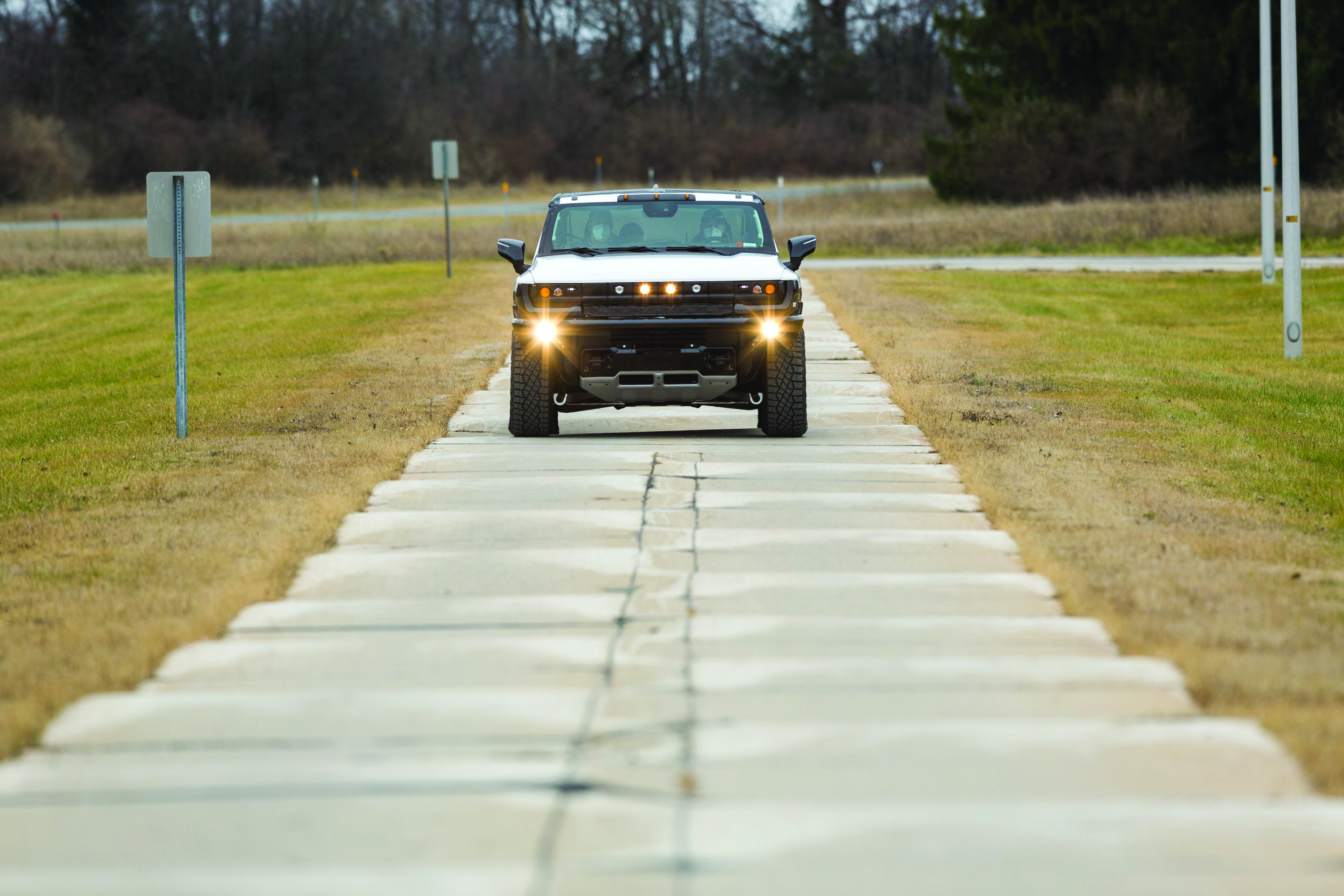Rapid development of this off-road behemoth blazes a trail for wider deployment of GM’s new Ultium propulsion system
There’s no more visible symbol of GM’s drive to go all-electric than the GMC Hummer EV, which launches later this year as a 2022MY pickup. An SUV variant with a 9in shorter wheelbase will follow two years later.
As befits the return of the iconic Hummer nameplate, there’s nothing understated about these off-road-ready models, which will boast up to 1,000hp of electric power from three electric motors, four-wheel steering with CrabWalk mode for inching out of tight spots, and 6in of extra ride height from an air suspension system.
The Hummer EV pickup also marks the production debut of GM’s new propulsion system badged Ultium
– a suite of battery, drive unit and power electronics technologies that will underpin an entire portfolio of electrified vehicles in the coming years. Development for Ultium began before the Hummer team hit the ground and continued through the pickup’s remarkably short, sub-three-year gestation.
“We took advantage of some of the core development work that we’d done on the Ultium platform, such
as for the cell and power electronics, which certainly helped accelerate the development of the Hummer,” explains Eric Sandstrom, GM’s chief engineer for global electric propulsion systems. “But the drive units are unique for the truck application, so that development is all new.”
Having a focused team was key to the speed of development.
“We put a dedicated team together right away, fully integrated with the vehicle team so that the propulsion system and vehicle were developed side by side. We had really fast decision-making and quick escalation to remove the roadblocks if any issues came up. That high-functioning, core team was co-located before the pandemic and I think that helped us to be very effective throughout the pandemic. We were well integrated before this all happened, with very good connections and relationships established, and a very well-defined mission,” Sandstrom says.
“Of course, we have had people on site pretty much throughout, working with hardware and development labs to keep the program moving forward,” he continues (see Mega shaker, p7). “We are still going through the same validation process that we do for every product. There is no compromising the development and validation of the product, it’s just been about working in a very different way.”
CAE acceleration
As one would expect, progress has been accelerated by CAE in the areas of battery and drive units, including for NVH simulation. According to Sandstrom, new tools weren’t necessarily required for the switch of drivetrain from ICE to battery electric.
“It’s the same physics in many cases, so even though it’s a very new application, a lot of the core CAE tools that we had in GM were leveraged to accelerate bringing the Hummer to market,” he says. “There was some [tool] development in the battery area, but the tools have fundamentally been in place and used here at GM for quite some time.”
One area where simulation was able to provide early feedback was in the use of the Visteon/Analog Devices wireless battery management system, which gets its first production application on the Hummer EV.
“Electromagnetic interference testing was done up-front, both at a component level and certainly at a pack level,” says Sandstrom. “And like anything, of course we had to make adjustments, but there was not too much course correction because the EMI had been simulated early on, as is the case for all of the electrical components. The system is performing very well.”
Battery testing
In the case of the Hummer, there’s a lot of battery to manage. In its highest-capacity, longest-range form, the pack consists of 24 modules, double-stacked in two layers of 12 in a cross-braced, underfloor enclosure that is integral to the wider vehicle structure. Sandstrom says that because each layer has its own cooling system and each module its own cold plate, testing did not reveal any issues with cooling such a large pack.
The pack has been subjected to extreme temperature use in the heat of the Western USA and in the cold
of Michigan’s Upper Peninsula.
“We’re covering the bases with testing up north and out west, but also in climate chambers – pack-level, component-level and vehicle-level chambers here in Michigan on the proving grounds and in the tech center,” Sandstrom explains. “It’s part of our standard battery of tests that we put every product through before we sell it.”
The Hummer’s go-anywhere remit means that at the time of writing in spring 2021, the pack and the new drive units were being put through some demanding off-road work, too.
“GM has a long history of developing powertrains for heavy-duty and off-road applications, so we’re taking that know-how that we’ve gained over many years [in conventional driveline components] and applying it to the drive units,” says Sandstrom. “The units are designed for off-road and the very high torque that this vehicle puts out.
“The battery itself is a structural component of the vehicle and as such, it’s very robust,” he continues. “We have skid plates under the battery and the front and rear drive units for off-road applications. It’s also a waterproof pack, with a breathable membrane to keep the pressure inside the pack balanced without it being subject to water ingress. This is an extremely capable off-road beast that can certainly handle any obstacles that are thrown its way – water fording as well.”
Long-term benefits
Sandstrom reveals that the Hummer’s architecture – battery enclosures for short- and long-wheelbase versions, and different module counts within those structures – will be carried forward into other GM electric trucks, so the validation work from this program will directly benefit future vehicle projects.
“I’m responsible for all the battery-electric truck propulsion systems and these will benefit from the work we’re doing on this first program because they all share the same propulsion system. The drive units we’re using will be reused, so other programs will benefit from the validation that we’ve done. That’s also true of the battery validation, even in this case at a pack level, because the structure that we’re bringing out for the Hummer is one that’s carried forward on all of our upcoming truck applications.”
The news that the Cadillac Lyriq is nine months ahead of its original launch schedule is proof that the reuse of Ultium components, combined with developments in virtual tools, is also accelerating GM EV programs beyond the truck family.
“All of the programs to come will benefit from what we’re doing,” Sandstrom concludes. “The component testing that we do on the cell, the cell modules, the motor and the power electronics are all building blocks
that we will use [in the future].”


Mega shaker
The Hummer’s vast, double-stacked battery pack has the mass of a small car so something equally massive was required to shake it. GM installed a new vibration table in its labs in Warren, Michigan, for the purpose. It weighs around 70,306kg and boasts thermal capability.
“A lot of infrastructure has also been put into our labs in Pontiac for the Hummer, in the dyno area, to
be able to pull the kind of power we need to drive these drive units,” adds Eric Sandstrom. “We have nothing [in the vehicle line-up] today that requires this kind of current, so we had to put in new drops and upgrade all of our dyno facilities to handle these drive units – not just to drive them, but also to absorb the power and torque that they put out.”


